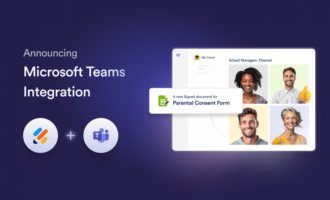If you’ve been looking for the ideal videoconferencing platform for your organization, you’ve likely discovered that there are a number of reliable videoconferencing tools to choose from. With so many options, including several that offer the same or similar features, it can be a challenge to decide which software is best for your particular use case. Today we’ll look at two of the most popular videoconferencing options you might want to consider: Microsoft Teams and Webex.
When comparing Microsoft Teams vs Webex, you’ll find that both tools offer similar features, including videoconferencing, individual and group chat functionality, messaging, file sharing, screen sharing, and other collaboration tools. Both offer an array of integrations with third-party apps, free plans with up to 100 meeting participants, and paid plans that offer advanced functionality. Teams is part of the Microsoft 365 ecosystem and offers robust document collaboration features, while Webex is well known for its video and webinar capabilities.
In this article, we’ll consider Microsoft Teams vs Webex, discuss the strengths and benefits of each tool, review both common and unique functions of each, and compare key product features, including security, customer support, integration options, functionality, and pricing plans.
Microsoft Teams: History, main functions, and target audience
Microsoft Teams is a cloud-based videoconferencing and collaboration platform launched in March 2017 as part of Microsoft’s Office 365 suite. Initially created to compete with Slack, Teams has grown from two million users at launch to 320 million as of 2023. While Teams was originally included with Microsoft Office 365, as of April 2024, it can be purchased separately.
Microsoft Teams is a comprehensive all-in-one solution, offering individual and group chat, voice messaging, document collaboration, an integrated calendar, file sharing, and videoconferencing, among other features. It integrates easily with Microsoft’s other well-known apps, such as Word, PowerPoint, Excel, SharePoint, and OneDrive, directly within the Teams interface. Its video meeting functionality allows screen sharing, whiteboards, virtual backgrounds, and more.
Microsoft Teams is used by 93 of the Fortune 100, according to PCMag. Because Microsoft 365 understands the complex needs of larger businesses and offers enterprise-level add-ons, licensing plans, and extensive integrations and security features, Teams is a good fit for large corporations, especially those that already use the rest of the Microsoft 365 suite of products. That said, many small and medium-sized businesses can also benefit from Microsoft Teams’ robust collaboration platform.
Webex: History, main functions and target audience
Webex was founded in 1995 and acquired by Cisco Systems in 2007. The Webex web conferencing platform merged with the Cisco Spark team collaboration app in 2018. As a result, Webex has transformed from a meeting and webinar solution to a full-fledged integrated collaboration tool with many of the same features as Microsoft Teams and other videoconferencing platforms.
The Webex videoconferencing and collaboration product suite includes meetings, calling, messaging, screen sharing, webinars and events, breakout rooms, recordings, polling, whiteboarding, and more. Webex offers both free and paid plans, and its free version allows users to create a video meeting with up to 100 participants. Its paid plans offer additional functionality, such as longer meetings, meeting capacity of 200–1,000 attendees, an AI assistant, and more.
Around 650 million people participate in Webex meetings each month, and around 39 million people use the cloud calling feature. According to the Webex website, 95 percent of Fortune 500 companies use its collaboration platform, including T-Mobile, the Dallas Cowboys, and Carnival Cruise Line, among others.
Known as a comprehensive videoconferencing tool, Webex is best suited for midsize and large companies, large group meetings, and enterprise applications. It’s a good option for hosting training events, webinars and presentations, and other larger-scale events, but Webex is also useful for small businesses looking to enhance their group collaboration.
5 key features of Microsoft Teams
Microsoft Teams offers several valuable features for businesses. Here are five that stand out.
Video meetings
The free version of Teams offers group calls and meetings for up to 60 minutes, with up to 100 participants per meeting. With Microsoft Teams Essentials, Microsoft 365 Business Basic, Standard, and Premium plans, and Microsoft 365 A1 plans, you can host online meetings and video calls for up to 300 people.
To start a video meeting, click Meet now in the Chat section or in your Teams Calendar. To schedule a meeting, click New meeting at the top of the calendar screen. Teams meetings provide features like customized backgrounds, meeting recordings, whiteboards, transcription, and more.
Chat
Teams offers both individual chats for one-to-one messages, and group chats. The chat function allows you to format text, use GIFs and emojis, and upload and share document and image files directly through chat sessions. These options are all available via the icons under the message field.
Channels
In Microsoft Teams, team members collaborate in channels. Channels can be public and open to everyone or private and focused on certain topics or activities. Select the Communities (for free accounts) or Teams (for paid accounts) section from the left side of the screen, then select Add Channel under the appropriate community or team. A name field will then pop up where you can name the channel.
Calendar
The Microsoft Teams calendar allows users to keep track of meetings, appointments, and other commitments. Users can switch between day, work week, and full week views. You can schedule meetings directly from the calendar or select a specific meeting in the calendar to get details about it. From there you can join the meeting, view call details, respond to the meeting invitation, chat with participants, or cancel the meeting if you’re the organizer.
Polling
The Teams polling feature allows users to create a poll from within a community, a meeting, or a group chat. The polling feature is ideal for situations when you want to get feedback on a team initiative, solicit ideas in a meeting, gather opinions about team challenges, or otherwise make meetings more interactive.
Other notable Microsoft Teams features
Other Microsoft Teams features, depending on the plan you choose, include webinars, external collaboration, screen sharing, voice calls, file sharing, access to cloud storage, and customized backgrounds and whiteboards for video calls. It also offers integrations with tools like Adobe Creative Cloud, GitHub, Google Workspace, and hundreds of others through the Zapier app.
5 key features of Webex
The Webex collaboration suite also offers many compelling features. Here are five that stand out.
Video meetings
The free version of Webex allows for video meetings of up to 100 participants with a meeting length of up to 40 minutes in duration. Paid plans allow meetings of up to 24 hours with 200–1,000 attendees, depending on the plan you choose. Users can schedule meetings from inside the Webex User Hub by selecting the Meetings tab, then choosing Start or Schedule to create a meeting.
Every Webex account also features a unique personal meeting room that allows users to schedule meetings as needed. All plans offer meeting features like unlimited 1:1 and team messaging, meeting recordings (saved to your computer on the free plan), screen sharing, and unlimited whiteboards, with lots of additional functionality available on paid plans.
Chat
Webex chat allows users to launch 1:1 and group message threads with both internal and external users. Users can also share files, access emoji reactions, share GIFs and other media, and more. These options all are available via the icons under the message field. Group chats are saved in the post-meeting summary and can be shared with attendees after meetings.
File and screen share
The Webex share feature allows users to share most file types, including DOC, GIF, JPEG, PDF, PNG, PPT, and XLS, up to 2 GB. Users can also preview documents less than 50 pages long or less than 100 MB without downloading them first. Additionally, users can share content via the screen share feature so everyone in the meeting can see what’s being reviewed or discussed.
Breakout sessions
The breakout room feature allows attendees to break away from the main meeting or webinar into smaller groups. Breakout sessions are ideal for workshops, classrooms, smaller discussions, or anything that needs to be addressed or resolved outside the main session.
Calling
The Webex Free plan allows unlimited messaging and calling with other Webex users. Depending on the paid plan you choose, you can also make calls from any device, and because calls are made over the internet rather than with the public switched telephone network (PSTN), users can make unlimited local and domestic long-distance calls. They can also make international calls that are billed by the minute.
Other paid plan calling features include voicemail with transcription, call queues, call routing, and more.
Other notable Webex features
Other Webex features, depending on the plan you choose, include AI assistance, polling, meeting analytics, meeting recordings saved to the cloud, advanced noise cancellation, a secure lobby to prevent uninvited guests, real-time transcriptions, webinars, and the ability to stream meetings to social media. It also offers integrations with third-party apps like Google Workspace and many other tools, as well as enterprise-grade security.
Common features of Microsoft Teams and Webex
When comparing Microsoft Teams vs Webex, you’ll see that both tools offer many of the same or similar features, so the videoconferencing solution you choose will depend upon the size and specific needs of your organization.
First, we’ll look at common features both tools offer. Then we’ll take a look at unique features of each videoconferencing option.
Both Microsoft Teams and Webex offer
- Videoconferencing
- A free plan that allows for meetings of up to 100 participants (The Teams free plan features 60-minute meetings, while the Webex free plan caps meetings at 40 minutes.)
- Integrations with hundreds of third-party apps
- File sharing
- Screen sharing during meetings and chats
- Messaging and chat functions for both 1:1 conversations and group interactions
- Meeting recording
- Whiteboard functionality
- Polling during meetings
- Emoji reactions during meetings
- The ability to customize notifications
- AI features with paid plans
- Voice over Internet Protocol (VoIP) calling, depending on the plan you choose
Unique features of Microsoft Teams and Webex
Each platform also offers unique features you may want to consider.
Here are some advantages of Microsoft Teams when compared to Webex:
- The meeting length on the Microsoft Teams free plan is 60 minutes; Webex allows just 40 minutes on its free plan. Paid Microsoft Teams plans allow meetings of up to 30 hours, while Webex paid plans allow meetings of up to 24 hours.
- Teams offers 5 GB of cloud storage on its free plan; Webex doesn’t offer cloud storage with its free plan.
- Microsoft Teams offers more pricing plan options, including two that are less expensive than the first paid tier in Webex.
- Teams has calendar and email tools, so you don’t have to set up a third-party integration.
- You also have access to to-do lists and planners without having to set up a third-party integration.
- It includes native integrations with the rest of the Microsoft ecosystem.
Here are some advantages of Webex when compared to Microsoft Teams:
- It offers each user their own virtual conference room, with a dedicated URL, that they can share with other Webex users.
- You can send video messages with the Vidcast video messaging tool.
- It offers more robust options for external collaboration than Teams does.
- It has a strong reputation for videoconferencing security, which includes locked personal room meetings, password-enforced meeting connections, and encrypted cloud recordings.
- It offers voice calling to all numbers in its basic plans. Teams supports calling other Teams users but requires a separate calling plan for full calling functionality.
- Users of Webex’s paid plans can host meetings of up to 1,000 participants without the need to purchase a separate product. With Teams, users must purchase a separate product with a different pricing structure to host meetings of this size.
Microsoft Teams vs Webex: A side-by-side comparison
Now let’s take a brief look at each product across five key areas: security, customer support, integration options, functionality, and pricing plans.
Security
Microsoft Teams offers multifactor authentication, data encryption for meetings and chats, single sign-on (SSO) and password protection for meetings, waiting rooms to control who can join meetings, advanced threat protection (ATP) for Teams and content shared across integrated applications, and built-in data loss prevention policies. Teams also provides compliance features for a broad range of security regulations, such as SOC, GDPR, HIPAA, and FedRAMP.
Webex offers enterprise-grade security, including end-to-end encryption, password protection, multifactor authentication, locked personal room meetings, meeting link expiration, and data loss prevention features. It also has features for complying with GDPR, HIPAA, SOC 2, FedRAMP, and other regulations.
Customer support
The free version of Microsoft Teams includes access to documentation on the Microsoft support website, along with video tutorials and community forums. Paid Microsoft 365 plans come with phone and web support. Microsoft 365 Business Basic and Standard plans offer a 99.9 percent uptime guarantee.
The support available in the Webex free version includes an online help center with an extensive knowledge base, community forums, Webex status notifications, and Webex Academy, featuring on-demand tutorials and e-learning courses. Webex paid plans offer email support, live chat support, and the option to speak to an expert or open a case. Webex Enterprise plan users get access to dedicated customer support agents.
Integration options
All Teams plans offer seamless integration with other Microsoft products, such as Word, Excel, and PowerPoint. Paid Teams plans allow additional collaboration with Microsoft 365 apps like Exchange, OneDrive, SharePoint, and Outlook. Teams can also integrate with non-Microsoft tools such as Google Workspace, Adobe Creative Cloud, GitHub, Trello, Asana, and hundreds of others through Zapier.
Jotform offers a Microsoft Teams integration that enhances collaboration and streamlines workflows. New form submissions or completed e-sign documents in Jotform can trigger a message to be sent to a Microsoft Teams channel or chat or to create calendar events in your Teams calendar or Outlook. The integration supports sending messages to standard channels or private channels, sending chat messages, and creating meetings.
Webex offers third-party integrations with hundreds of tools and applications across an array of categories, such as analytics, calendars and scheduling, customer relations, document management, marketing and sales, productivity, project management, and more. You can also use Zapier’s Webex Meetings integrations to connect with numerous additional tools.
Functionality
Teams is a robust platform with many compelling features, including videoconferencing, chat, an abundance of productivity and collaboration capabilities, and much more. Because these features live in a single dashboard, there can be a steep learning curve for new users. If you simply want to use its video meetings and conferencing functions, it can be challenging to navigate.
That said, once users become familiar with Teams, they may find its extensive functionality superior to other videoconferencing tools, and current Microsoft 365 users will likely find it simple to navigate.
The Webex interface is clean, easy to navigate, and user-friendly. The initial setup for Webex is also more straightforward and requires less configuration than Teams. The platform makes it easy to add users, start meetings, and access other key features.
To be fair, some users have reported that Webex is challenging to understand and complicated to set up. As someone who used Microsoft Teams extensively when working in a large-scale organization, I found Webex easier to navigate and get started with and its features more intuitive to use overall during my research, but I didn’t test the Webex paid plans with advanced functionality.
Pricing plans
Microsoft Teams offers a variety of pricing plans for both business and personal use.
The Teams free plan includes unlimited 60-minute video call sessions with the capacity for 100 participants per session, unlimited chat with friends and family, file sharing, 5 GB of cloud storage, and data encryption for meetings, chats, calls, and files. Here’s an overview of the paid plans:
- Microsoft Teams Essentials: At $4 per user per month, this plan includes unlimited group meetings for up to 30 hours, with up to 300 participants per meeting; 10 GB of storage space; unlimited chat with coworkers and customers; whiteboard functionality; file sharing; tasks; polling; data encryption for meetings, chats, calls, and files; hundreds of collaborative apps; team meeting recordings with transcripts; and more.
- Microsoft 365 Business Basic: This plan is $6 per user per month and includes everything in the Teams Essentials plan, plus a custom business email; 1 TB of cloud storage per user; 10-plus additional apps for your business needs (Bookings, Planner, Microsoft Forms, and others); web and mobile versions of Word, Excel, PowerPoint, and Outlook; anytime phone and web support; and more.
- Microsoft 365 Business Standard: For $12.50 per user per month, the Business Standard plan includes everything in the Business Basic plan, plus webinars with attendee registration and reporting; desktop versions of Word, Excel, PowerPoint, and Outlook; collaborative workspaces for co-creation using Microsoft Loop; and video editing and design tools with Clipchamp.
- Microsoft 365 Business Premium: At $22 per user per month, this plan includes everything in the Business Standard plan, plus advanced security, access and data control, and cyberthreat protection.
Check out more details about Microsoft Teams Business Plans.
The Webex Free plan includes unlimited 40-minute video meetings with up to 100 participants per session, desktop and app versions, file and screen sharing, unlimited 1:1 and team messaging, unlimited whiteboard functionality, local storage of meeting recordings, and video messaging by Vidcast.
Here’s an overview of the paid plans:
- Webex Meet: At $12 per user per month, this plan includes everything in the Webex free plan, plus AI assistance, meeting lengths of up to 24 hours, up to 200 attendees per meeting, advanced noise cancellation, 10 GB of cloud storage of meeting recordings, closed captions, cohost privileges, a secure lobby to prevent uninvited guests, and live polling and Q&A.
- Webex Suite Meet + Call: This plan is $22.50 per user per month and includes everything in Webex Meet, plus a business phone number, the ability to call any telephone number, visual voicemail, the ability to move your call from one device to another, six-way conference calling, unlimited local and domestic long-distance calling, and international long-distance calling with per-minute billing.
- Webex Enterprise: Pricing for the Enterprise plan requires a custom quote. It includes everything in the Webex Suite, plus meetings with up to 1,000 attendees, local and unlimited cloud meeting recording, and FedRAMP authorization.
Get more details about Webex plans and features.
| Microsoft Teams | Webex | |
|---|---|---|
| Meeting participant capacity | Free plan: 100 Microsoft 365 plans: 300 E5 (Enterprise): 1,000 | Free plan: 100 Webex Meet: 200 Webex Suite: 200 Webex Enterprise: 1,000 |
| Video quality | 1080p | 720p by default |
| Cloud storage per user | 5 GB in free plan; 10 GB–1 TB in paid plans | None in free plan; 10 GB–unlimited in paid plans |
| Main features | – Audio and videoconferencing – Chat functionality – Meeting collaboration tools, such as screen sharing, file sharing (including real-time document sharing and editing), virtual whiteboards, polling, and more – Meeting recordings – Meeting transcription – Integration with Microsoft Office 365 Suite products like Word, Excel, PowerPoint, Outlook; integrations with non-Microsoft tools, including Google Meet, Google Drive, Trello, Asana, and many others; additional integrations via Zapier – Room systems with breakout rooms, webinars, single meeting organizer | – Audio and videoconferencing – Chat functionality – Meeting collaboration tools, such as screen sharing, file sharing, whiteboards, emoji reactions, polling, and more – Meeting recordings – Meeting transcript display when you play the recording – Hundreds of integrations through the Webex App Hub; additional integrations through Zapier’s Webex Meetings integrations – Breakout sessions for smaller group discussions – Separate paid plan for Webex Webinars |
| Customer support | – Support for the free version through documentation and educational resources on the Microsoft support website – Phone and web support for paid Microsoft 365 plans | – Support for the free version through the online help center and extensive knowledge base, community forums, and Webex Academy, featuring on-demand tutorials and e-learning courses – Email support, live chat support, and the option to speak to an expert or open a case for Webex paid plans |
| Security | – Two-factor authentication – Data encryption for all data in transit and at rest – Single sign-on and password protectionWaiting rooms to control who can join meetings – Advanced threat protection (ATP) – Built-in data loss prevention policies – HIPAA, GDPR, FedRAMP, and SOC compliance features | – Enterprise-grade security and compliance features – End-to-end encryption – Password-protected meeting connections – Multifactor authentication – Locked personal room meetings – Meeting link expiration – Data loss prevention features – Compliance features for GDPR, HIPAA, SOC, FedRAMP and other regulations and standards |
| Pricing plans | – Free plan – Microsoft Teams Essentials: $4/user/month – Microsoft 365 Business Basic: $6/user/month – Microsoft 365 Business Standard: $12.50/user/month – Microsoft 365 Business Premium: $22/user/month – Enterprise plan available | – Free plan – Webex Meet: $12/user/month – Webex Suite Meet + Call: $22.50/user/month – Enterprise plan available |
| Platform support | Mobile (Android and iOS) Web application Desktop (macOS and Windows) | Mobile (Android and iOS) Web application Desktop app (macOS and Windows) |
Photo by Polina Zimmerman















































Send Comment: